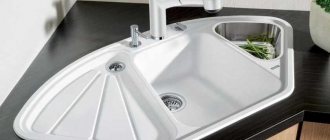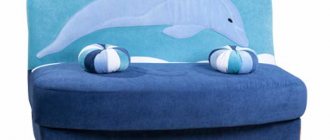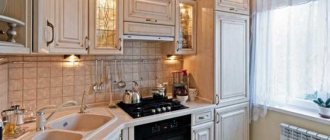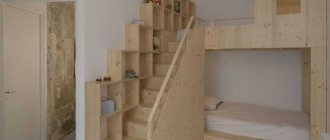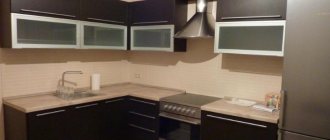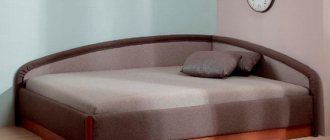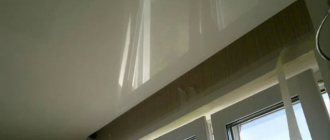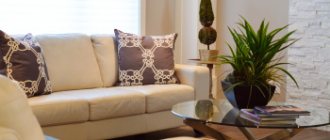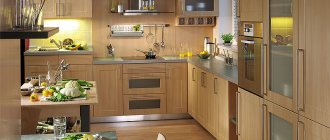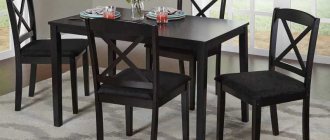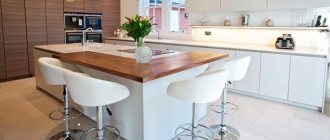History of origin
MDF was first used in America in the 60s of the last century. This material appeared as a result of improvements in the fiberboard production process and was called Medium Density Fiberboard, which translated means medium-density fiberboard. The expensive and hazardous “wet” process for making fiberboard has been replaced by dry pressing of shredded wood chips. In the USSR, MDF production was not established. In the CIS countries, the production of this unique material was mastered in 1997. Today, China is the world leader in the production of MDF boards.
Chipboard is a traditional material for the body
Most often, kitchen cabinet bodies are made of laminated chipboard. This material has good moisture resistance, mechanical strength and ease of processing. It is easy to drill, saw, paint, glue, etc. Such boards are not susceptible to temperature changes, are extremely rarely affected by mold fungi and are easy to maintain.
Sometimes kitchen cabinets are made of MDF. The material has better consumer properties, but is significantly more expensive and weighs more. Much less often, natural wood is used to make cabinets; such kitchen furniture belongs to the premium class.
Technology and production stages
Fiberboard production is an improved process for making chipboard or fiberboard, although MDF boards differ in strength. The process of manufacturing fibreboards includes several interrelated stages:
1.Preparation of raw materials
The basis of the material is small wood shavings, which are obtained from logs cleared of bark, which are subsequently chopped into chips. Sometimes shavings can be obtained by grinding waste from the wood processing industry. Next, the chips go through the stage of cleaning from dirt, sand, and foreign objects. The resulting workpieces are treated with steam under high pressure, after which they are transferred to rotating disks. At this stage, the wood fiber is ground so finely that it resembles felt. Next, the material is thoroughly dried.
Prepared wood logs for subsequent processing
Wood chips
Processing wood chips into wood flour
Wood flour formation
2. Gluing
The resulting wood fibers are held together by natural resins that are released from the wood when heated. Also at this stage, a mixture of binders is added, including urea-formaldehyde resins and paraffin. The resulting homogeneous mass is dried under the influence of temperature. Next, air is removed from it using cyclones.
3. Formation of layers and pressing
The glued and dried fiber is leveled on a special forming machine under the influence of forming rollers. Next comes weighing on scales and pre-pressing. Then the slab goes to the main press. As a result, the finished material is formed - MDF. Next, the tape is cut into specific sizes with a dividing saw and cooled for 30 minutes.
4. Sanding
Finished MDF panels are sanded. This is necessary to even out the thickness, make the surface smooth, and remove possible defects. At this stage, the production process of MDF panels is completed. In this form, the material can be sent to the consumer.
MDF board without decorative coating
5. Decorative finishing
To give MDF panels decorative qualities, they are subjected to finishing, which can include painting, lamination or veneering.
Each stage of production occurs under the supervision of qualified specialists. At the end of the process, the batch is tested in the laboratory for many indicators: moisture resistance, density, strength, roughness. It is mandatory to check for formaldehyde content.
MDF boards: what they are, where and how they can be used
The abbreviation MDF stands for finely dispersed fraction. Such boards are made from wood fibers, the density of which corresponds to average values, by pressing them under high pressure conditions.
Production of MDF panels
The areas of application of the resulting slabs are diverse. For many manufactured factory products, MDF acts as a base. Let's consider several main areas of using this material in everyday life:
- MDF sheet panels are used for finishing floors and ceilings;
- covering walls with MDF panels is also quite common;
- production of furniture, the facades of which can have either a smooth surface or be decorated with carved elements;
- due to its properties, MDF is widely used as a soundproofing material, allowing to significantly reduce audibility between rooms;
- A more unusual, but very popular use of this material is the transformation of steel doors. MDF is used as a decorative overlay on an existing surface, thus improving its appearance. At the same time, you can buy MDF linings for entrance doors in a wide variety of variations and colors.
MDF wall panels for bedroom decoration
This material has become so widely used due to the fact that in its production process only materials that are completely safe for human health are used, in particular carbide resins. In addition, such boards have excellent technical characteristics: heat and moisture resistance, and are not susceptible to the formation of various types of fungi and mold on the surface and inside the chips. All this makes MDF boards a worthy competitor to natural wood.
Advantages
- The versatility of the material. Due to the structure of the material, it is very popular and widely used in various areas of human life: furniture industry, construction, interior design.
- Practicality. MDF is a fairly hard material and is not subject to minor mechanical damage. In addition, due to their density, the slabs perfectly hold fasteners, which significantly extends the life of furniture, wall or ceiling panels.
- Decorative. A rich variation range of MDF boards allows even the most demanding consumer to choose an option.
- Environmental friendliness. In the manufacture of MDF panels, no synthetic additives are used, which makes it possible to compare the safety of the material with natural wood. The use of natural ingredients makes MDF safe for health. Even over time, the material does not emit toxic compounds.
- Hygiene. Fiberboards are not subject to the natural process of decay, as well as to the influence of other pathogens that destroy the base of the material.
- Moisture resistance. MDF is not exposed to moisture, does not swell or warp.
- Uniformity of the material. MDF boards are made from a homogeneous mass of wood fibers mixed with an adhesive composition, which guarantees the absence of external and internal defects. The slabs are absolutely smooth and even.
- Lifetime. Compared to solid wood furniture, MDF products will last much longer if properly cared for.
- Heat and sound insulation.
Kitchen with plastic coating
The price of a kitchen with a plastic coating is significantly higher than the previously listed options. However, we must admit that the high cost is completely justified. These kitchens combine all the best characteristics. These facades are made by attaching plastic to a base using pressure and high temperature.
The production methods for plastic-coated facades are as follows:
- application on chipboard;
- application on MDF.
There are several options for designing the ends. You can decorate them using PVC, acrylic edges, or you can make the ends without seams.
The plastic coating will not peel off over time, which cannot be said about PVC. This is guaranteed by the manufacturing method, during which the coating actually “sticks” to the base. This coating is characterized by high strength. It is practically not damaged, it is not afraid of either hot frying pans or sharp knife blades.
Plastic also has its disadvantages. They are very similar to the disadvantages of painted MDF, but not as natural. The glossy surface of the plastic may show fingerprints, which may require cleaning more often than usual. This drawback will be especially noticeable under artificial lighting.
| pros | Minuses |
| Good resistance to humidity | Difficult to maintain surface |
| Long service life | There are sometimes slight distortions on the facades |
| Chemical resistance | They are expensive |
| Large selection of colors | |
| Ultraviolet light is not dangerous for them |
Wooden kitchen fronts
Wood is a classic material for creating furniture. The solid wood set looks solid and brings the warmth of home comfort to the interior. Natural materials always look elegant, but they are quite expensive.
Kitchen facades made of wood are divided into two types:
- from solid wood;
- paneled (in a wooden door an insert is made from cheaper material).
| pros | Minuses |
| Luxurious view | Expensive purchase |
| Environmental friendliness | Difficult to care for furniture |
| Long service life | Deteriorates from ultraviolet radiation |
| Possibility to decorate in various ways | Easily damaged by moisture |
Now you know that asking which material for the kitchen is better to choose: MDF or plastic is wrong. Here it is rather worth asking what coating to choose for the kitchen set? You should choose based on their characteristics, clearly comparing all the advantages and disadvantages.
AllaAuthor of the article
Did you like the article?
Share with your friends:
Flaws
- Highly flammable. MDF ignites quickly when in contact with an open flame. In addition, the material may ignite upon prolonged contact with hot objects. Even faulty wiring next to MDF furniture can cause an ignition.
- Low resistance to mechanical damage. Despite the high density of the material, particle boards can be damaged if a heavy object falls or is hit.
- The need for additional drilling of holes for fasteners. Due to the hardness of the material, it is impossible to drive a nail or screw a screw into it; you must first drill the necessary holes for subsequent connection of the parts.
- Dust. During processing of MDF, a huge amount of fine dust is generated, so it becomes necessary to use a respirator to prevent small particles from entering the respiratory tract.
- Price. Particle boards are highly expensive compared to other materials - chipboard, fiberboard. To a greater extent, this is due to the fact that the production of this material has not been established in our country.
Materials for making a headset with your own hands
Furniture facades can be made with your own hands if you have the desire and some skills in working with carpentry tools. This is unlikely to be done from scrap materials and will require a little work.
The following façade materials for kitchen manufacturing are available to the home craftsman:
- Natural wood.
- Chipboard.
- Glass and aluminum profile.
- Plastic panels.
If you don’t want to tinker, you can buy ready-made facades. They are of standard size, and there is a large selection of such products on sale in various materials.
The cases are made of laminated chipboard. It is recommended to order a ready-made cut with a sticker on the edges, because this is difficult to do at home. Laminate countertops can be ordered there. We sell ready-made countertops of standard sizes (270, 300 cm, etc.), which are sawed to size and hemmed yourself.
MDF classification
Particle boards are divided into several categories depending on the outer covering of the material. The following types of MDF are distinguished:
- painted;
- laminated;
- veneered
Painted MDF boards
Laminated MDF boards
Veneered MDF boards
The most inexpensive material is painted MDF. Painting does not protect the product from mechanical damage and wear. They are also vulnerable to moisture. However, painted MDF boards are highly decorative and allow you to implement many design solutions.
Laminated MDF boards are produced by covering them with a special PVC film, which makes the material decorative. Thanks to the film, MDF can have various colors that differ in texture and texture. The surface can be glossy or matte. Due to lamination, the material is highly resistant to moisture and mechanical damage.
Veneered MDF boards look like solid wood and have a very attractive design. Veneering involves gluing the thinnest slabs of natural wood to the surface of particle boards.
Types of coatings for kitchen facades
The quality and appearance of the kitchen directly depends not only on the base of the body, but also on the coating. The same facade can be covered with different materials. And it is the combination of these two factors that will determine the final result.
MDF facades coated with plastic
Such facades have another name – plastic. Such furniture will exist for a very long time, since this material is practically not subject to external influences. Facades are suitable for almost any interior. The color range is varied.
Various color solutions for MDF facades
Finishing MDF with laminate
The cheapest façade option in terms of price and appearance. The essence is chipboard covered with several layers of paper and polymer resin. The top layer is decorative. Almost any pattern can be applied to it. Most often, this is an imitation of wood or stone.
Such furniture loses its attractive appearance in just a few years. The pattern of the top layer is erased, the layers become soaked from moisture and steam.
Facades made of MDF panels coated with high-gloss enamel
The use of high-gloss paint in the design of kitchen facades is a new trend. It is best to paint MDF panels, since they can be purchased in any size and even shape. Even products that have a visual effect have come into fashion. It could be a chameleon kitchen or even a 3D coating. In this case, everything depends on the customer’s imagination.
An interesting and extremely unusual solution
Finishing MDF with acrylic
Another possible finishing option for MDF panels is coating them with acrylic. As a result, the customer receives the most durable plastic, extremely glossy and bright. A huge advantage is the ability to repair this surface - scratches can be removed with an ordinary grinding machine.
It will not be possible to endlessly correct the consequences of careless handling. And on the gloss, all the damage is very visible.
Facades made of laminated chipboard panels
Lamination of chipboard is a fairly old processing method. For this purpose, special resin and a press are used. The top layer is a special paper film impregnated with resin and coated with paraffin. A huge and main plus is low cost in relation to fairly high wear resistance.
But there are also disadvantages to laminated chipboard panels - the material is difficult to work with, which is why it is almost impossible to make complex structures from it.
Application
The use of MDF boards is very common in various industries. this is due to the high strength, reliability, and environmental friendliness of the material. The use of MDF is popular in the furniture industry. It is used for the manufacture of cabinet furniture, commercial equipment, and shoulder straps. Thanks to its dense structure and numerous color variations, this material is widely used for the manufacture of exclusive luxury furniture. The possibility of fine processing allows you to create unique furniture masterpieces. MDF boards with decorative coating are used for the manufacture of furniture facades for PVC cladding. MDF is often used in the manufacture of countertops.
The current use of fiberboards in construction:
- in the production of doors;
- in the manufacture of laminated flooring;
- in the manufacture of window sills;
- for leveling walls;
- when creating arches, partitions and other interior elements;
- in the production of wall and ceiling panels;
- as a heat and sound insulator.
The use of MDF boards is also widespread in other areas, for example, in the cladding of train cars, trams, buses, and in the manufacture of warehouse packaging for non-food products. Cases of various musical instruments, as well as acoustic systems, are made from MDF.
The advent of MDF revolutionized the furniture industry. This material is significantly inferior in price to natural wood and at the same time, in terms of technical characteristics, it is on par with it, and in some aspects even superior. The material is easy to process, and due to its density and uniformity, it allows the production of shaped products. It is not subject to rotting, drying out, does not warp or deform. Today, MDF is one of the most popular materials in the furniture industry.
Caring for MDF and chipboard furniture in the kitchen
Kitchen hygiene is an important element of health.
Products come into contact with kitchen furniture, and therefore care for it must be extremely careful. MDF and laminated chipboard behave differently, so you need to carefully study the features of each material:
- Chipboard lamination can be damaged by any active chemicals. Therefore, when cleaning the kitchen, you should use a regular soap solution. This can make it difficult to remove grease drops and other stubborn stains.
- When cleaning MDF, you can use any detergent. However, you should avoid harsh abrasives and sponges with a scratchy surface to prevent scratches.
Thus, we can conclude that MDF is much easier to clean and allows for greater hygiene.
